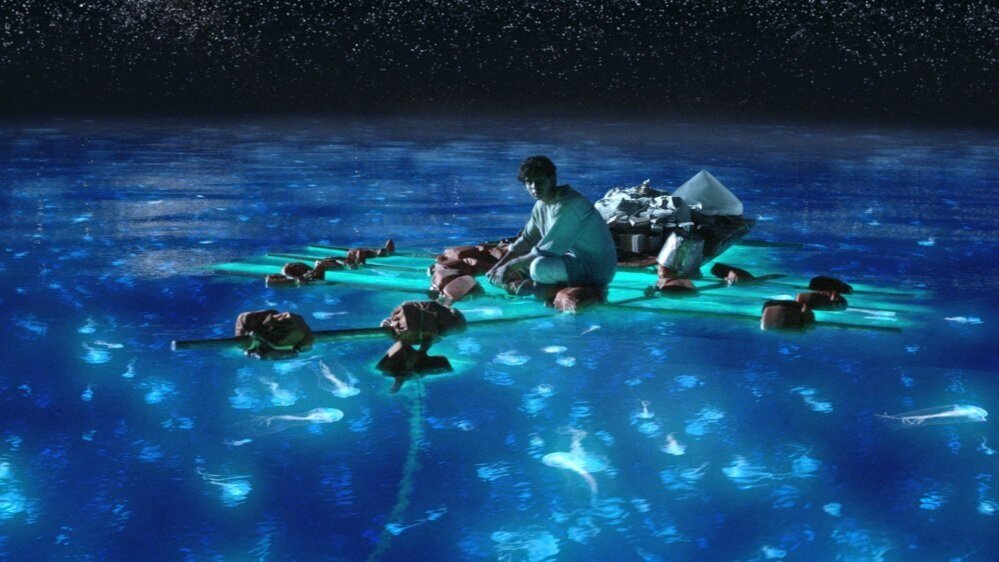And So It Goes With God: Ang Lee's Life of Pi
From his early Taiwanese films to his later marvels, Ang Lee has explored humanity and compassion, religion and spirituality. His movies are all different from each other (a Jane Austen adaptation, a cowboy romance, an Iraq war satire/drama, etc.). And yet Lee’s sensitivity and empathy continue to come through over the vast span of genres and settings. In 2012, Lee undertook the adaptation of Yann Martel’s hit novel Life of Pi, a source material that had been previously deemed unfilmable. The film was a critical and commercial success, scoring Lee his second Best Director Oscar. Life of Pi also marked a turning point for his career, as he became fascinated with tinkering with technology to push cinematic boundaries. The visual wonder aside, Life of Pi is a symbolic, mystical journey to find God.
Life of Pi is told through flashback: Pi Patel (Irrfan Khan) tells a writer (Rafe Spall) about how he survived at sea in a lifeboat with a Bengali tiger named Richard Parker. His family owned a zoo in Pondicherry, India. In the 1970s, his parents (Tabu, Adil Hussain) decided to immigrate to Canada, intending to sell the animals there. In a violent storm, their ship sinks and Pi (now played by Suraj Sharma) is the lone survivor with Richard Parker, a hyena, an orangutan, and an injured zebra. Soon, Pi finds himself alone with the tiger after the hyena kills the other animals, and Richard Parker kills the hyena. Pi attempts to tame Richard Parker, while figuring out a way to survive at sea. Throughout their journey, Pi forms a tentative bond with the tiger and experiences an existential awakening.
The film, just like the novel, is famous for its hook: a boy and a tiger lost at sea on a lifeboat. And it’s easy to feel impatient during the film’s opening act in India, where Pi details his childhood, the origin of his unusual name, and his early encounter with Richard Parker. However, Pi’s childhood—including the origin of his unusual name and his adopting of Hinduism, Islam, and Christianity—is narrated with a scale almost as epic as his adventures at sea. Life of Pi, a film about mythmaking, presents Pi’s whole life as a legend filled with larger than life characters and unique incidents. For example, Pi is named after the French swimming pool Piscine Molitor, his eccentric uncle’s favorite place. He develops a fascination with Richard Parker, named after an amusing clerical error confusing the tiger with the hunter who caught him. Pi’s father warns him that humans project their own emotions onto animals, a theme that pays off to devastating effect at the end.
Life of Pi sets itself up as an epic story through this deceptively grand opening, and as a result, the fantastical elements of the story (for starters the hard-to-believe premise of a boy and a tiger lost at sea) are not only easier to accept, but take on a transcendent quality. One can watch Life of Pi as a surface-level adventure story, and Lee’s confident, exciting direction rewards that exceedingly. However for me, the film works more as an emotional and spiritual journey. Lee explores the concept of man vs. nature and man vs. animal not just on a survival level, but also within the context of Pi’s faith in God. Pi’s journey, and the complete tragedy of his life, causes him to wrestle with his faith in God. His desperation to believe is profoundly felt, especially in the climatic rainstorm sequence where he surrenders to God after all the misfortunes he’s experienced.
Because of this doubt, Ang Lee isn’t delivering a sermon or religious manifesto. The film is about questioning. This is further explored with the motif of the unreliable narrator. Part of the joy of mythmaking is the idea that myths strike the balance between credulity and incredulity. When Pi is inevitably rescued off the beach in Mexico, insurance agents question the veracity of surviving at sea with Richard Parker. So Pi tells a different a story, replacing the animals with humans (Richard Parker representing himself). The viewer is forced to imagine humans killing and eating each other. That is such a horrifying image, and again the film reckons with the man vs. animal theme. Both the insurance agents and Ifans’ writer ask which version is actually true. Pi lets us decide which one we prefer, and everyone would choose the fantastical story with Richard Parker the tiger. “And so it goes with God,” is Pi’s enigmatic response.
Life of Pi is one of Ang Lee’s most sumptuous films, which is saying something. And it’s not just the visual effects and rendering of the animals. Lee’s gorgeous sense of camera placement, scale, color, and editing are remarkable. The aesthetic is magnificent: clear blue water, never-ending skies, and lush greens. Cinematographer Claudio Miranda, editor Tim Squyres, and composer Mychael Danna all do stunning work, as do the actors especially Suraj Sharma. The film’s individual sequences (the whale, the meerkat island, the hallucinatory underwater night sequence) are jaw dropping, handled with care and elegance. On land, India looks dazzling, with a warm, nostalgic glow. Ang Lee is perhaps the only director who could tackle something like Life of Pi as someone who can discover spiritual and existential truths amidst a CGI spectacle.














